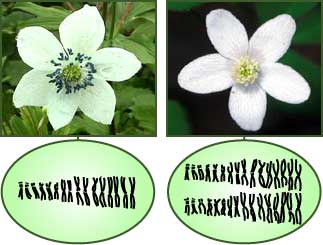In terms of reproduction, plants have a lot more options than animals do. Many plants can reproduce sexually, by fertilizing other individuals or themselves, and asexually, by creating clones of themselves through vegetative reproduction, while most animals only reproduce sexually.
Similarly, in terms of speciation, plants have more options than animals do. Two modes of speciation are particularly common in plants:
- Speciation by hybridization: For example, when Loren Rieseberg and coworkers reconstructed the phylogeny of several sunflower species, they found that several species had been formed by fertilizations between other species. Often the hybrid offspring of such fertilizations are sterile, but occasionally they are fertile and are reproductively isolated from their “parent” species. In the latter case, a new species is formed.

- Speciation by ploidy changes: In terms of plant speciation, a ploidy change generally means multiplying the number of chromosomes the species has by some number. So a species that normally has 18 chromosomes might produce a lineage that has 36 or 54 chromosomes. Ploidy changes are common in plants and often produce a species that is reproductively isolated and distinct from the “parent” species. For example, speciation in these anemones involved a ploidy change.

Learn more about speciation:
- A closer look at a classic ring species: The work of Tom Devitt, a research profile.
- Sex, speciation, and fishy physics, a news brief with discussion questions.
Teach your students about speciation:
- Anolis lizards, a classroom activity for grades 9-12.
Find additional lessons, activities, videos, and articles that focus on speciation.
